If you ask Chinese people to describe our daily life with one sentence, the most common and popular answer might be: 柴米油盐酱醋茶, literally translated as fire wood, rice, oil, soy sauce, vinegar and tea. Tea has been a treasure for Chinese people in quite a long history. Although there are some controversies about the single origination for camellia sinensis, whether from Burma, or China’s Yunnan and Sichuan province, there are many historical records showing tea plants have a record over 4000 years in China (in Shennong) and it was firstly used as a medicinal drink or a bitter drink in Chinese Shang Dynasty. Drinking tea has formed as a common activity in Tang Dynasty.
Generally speaking, there are two groups of tea: one group is made from the leaves of camellia sinensis, which is considered as the real tea and another group is made from herbs and flowers, which is also known as herb tea. Like most of people in my country, I love tea too. To our Chinese, tea is treasure. We love the tastes, benefits from daily intakes and enjoy the tea ceremony and dedicate Chinese tea sets.
IF LIFE IS A CUP OF TEA, IT’S ALL IN HOW YOU MAKE IT.
Now let’s start with real Chinese tea.
With over 3000 varieties, technically, all type of tea comes from the same plant, the evergreen shrub: Camellia Sinensis. By pouring hot water to those tealeaves, aromatic beverages are presented. In China, based on the tea processing, tea is further grouped into green tea, black tea, yellow tea, white tea, oolong tea and dark tea. Differences lay in the method of harvesting, treatment and processing. Early tea farmers found that the tea tasted better if the bushes were pruned and controlled. So the tea shrubs are generally kept well pruned for a better quality of young shoots. According to the final type, picked leaves are dealt with different tea processing techniques.
Green tea is un-oxidized tea, which contains largest amount of tea polyphenols (nearly 30% of the net weight). Fresh tealeaves are picked and heated directly in order to stop the oxidization process. Compared with other consumed tea like black tea, green tea wins popularity due to its healthy effects.
Yellow tea is similar to green tea with a longer drying phase, which further allows slightly oxidizing process. Usually yellow tea has a very yellow-green and bright liquid appearance, and slightly different taste from white tea and green tea.
White tea is slightly oxidised tea made from the buds and leaves of Chinese Camelli Sinesis plants. Usually white tea is dried naturally or gently, which remains the white edges. This is Elaine’s personal favorite.
Oolong tea is semi-oxidised tea, which is between green tea and black tea. Moderate oxidation makes the leaves become slightly red. The taste of oolong tea combines the freshness of green tea and aroma of black tea.
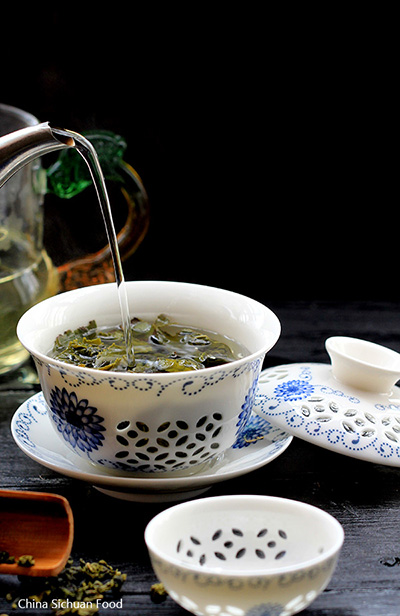
Black tea is further oxidised than oolong tea. It is named after the red color of the tea liquid. In Chinese, black tea is referred as “红茶 ”, literally means red tea.
Dark Tea is post-fermented tea, which is unique to China. Dark tea is more fermented than black tea and oolong tea, usually with a longer quality guarantee period and more infusions. It is named after the black color of the fermented tealeaves. One famous representative is Chinese Pu-erh tea.
In additionally, there are scented teas like osmanthus black tea, jasmine green tea and lotus green tea. Flowers are used to flavor tea during the blending or oxidizing process. Scented tea essentially belongs to the category of the tea base. For example scented green tea belongs to green tea and scented black tea belongs to black tea.
Herb and Flower Tea
With a long history back in Ancient Egypt and Ancient China, herbal tea has become quite popular word widely. Generally, the antioxidant properties of herbal teas are lower than true tea from Camellia Sinensis, but they still can provide powerful antioxidants. In China, herbal teas are loved especially by woman and older because of the fragrance and therapeutic applications including simulant, relaxant or sedative properties. Herbal Tea might be made from flowers, roots, seeds and leaves.Following are some of the most popular herbs and flower tea in China.
Chrysanthemum tea (菊花茶) is extremely popular in China for hundreds of years, listed as one of the top ten most popular herbal teas. Usually chrysanthemum tea is infused with wolfberry and sweetened by sugar. Chrysanthemum tea is believed to protect our eyes and promote eye health, relax body and mind and have strong antibiotic effects.
Rose tea(玫瑰花茶), made from pickled and dried rosebuds before a chance to blossom, is listed as the top 10 beneficial flower teas in China, where it has been used for thousands of years. The most outstanding benefit of rose tea in Traditional Chinese Medicine is to relieve cramping during menstruation. Unlike taking pills, drinking rose tea is safer and continuing improving the condition. Besides, regular rose tea intake can help adjust endocrine disorders, further cure menstruation cramping gradually. In China, a common combination for menstruation symptom is rose tea with natural brown sugar extracted directly from sugarcane. Do not drink too much, if you are suffering from menorrhagia.
Hibiscus tea (roselle tea or “sour tea” 洛神花茶 ) is an herbal tea made from hibiscus sabdariffa flower, severed as hot or cold. It has been enjoyed for a long time worldwide. Though not originated from China, Hibiscus gains great popularity among Chinese people in recent years. Hibiscus tea is featured by its gemstone like red color and lemon like sour taste. The strong red color of hibiscus tea comes from the rich acidic polysaccharides and flavonoid glycosides. And usually this is why it is commonly added to other tea mixture, for the improvement of the tea color. Hibiscus tea has lots of benefits including blood pressure controlling, rich vitamin especially vitamin C and relieve sore throat caused by a cold.
Jasmine flower tea (茉莉花茶)is considered to be spring flower tea, usually made from jasmine buds. Jasmine is believed to help to balance body heat, clear eyes, detox liver, relax body, improve circulation, lower cholesterol, improve digestion and fight off flu.
Honeysuckle tea (金银花茶) has been on of my most familiar tea, as we get lots of wild honeysuckle growing in the large mountains behind my grandma’s house. Honeysuckle has the potential benefits of anti-inflammatory, reducing fever, alleviate sore throats and relieve dental arthritis.
Osmanthus tea 桂花茶 is made from dried Osmanthus flower. Mature in August, fresh Osmanthus flower usually has a strong fragrance. However dried Osmanthus flower has a very fait aroma. Osmanthus flower can help to lighten the skin, improve complexion, boost the immune system, protect stomach from cold, and reduce phlegm.
Lavender tea (薰衣草茶) is made from the infusion of dried flower of Lavandula angustifolia, which is the most common one specie of the lavender family. Although native to Mediterranean, this special specie is now cultivated in China too. Similar to chamomile tea, lavender has a strong sedative property and performs as a natural relaxant. Additionally lavender tea may help to relive digestive issues like stomach infections or bowel infections.
Additionally, we use dried lotus leaves, Chinese wolf berry, apple flower and red dates in daily brewages too.What’s your favorite and how do you use them in daily life, cooking and drinking?

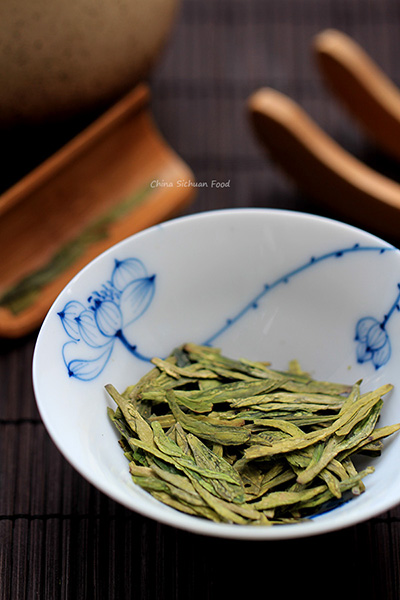
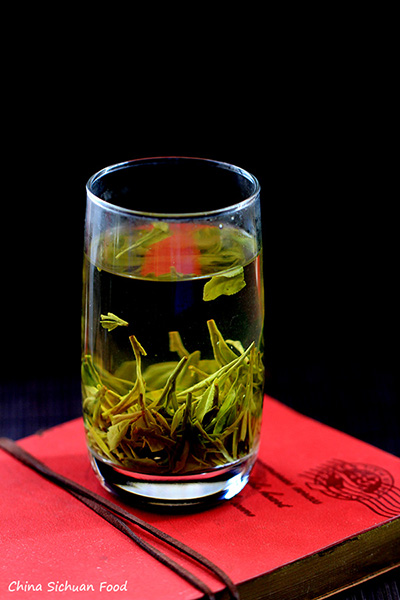
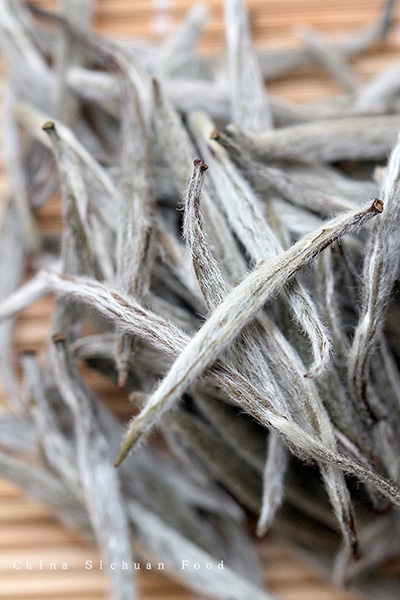
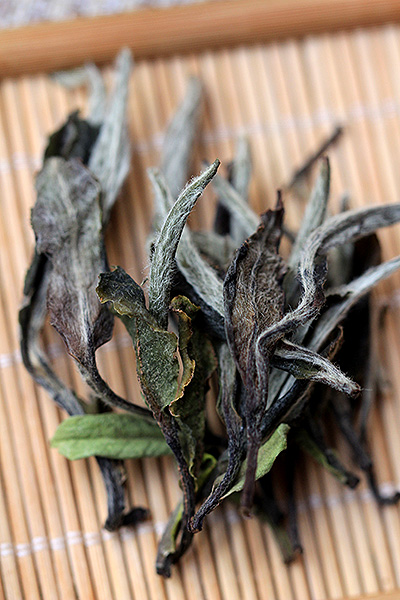
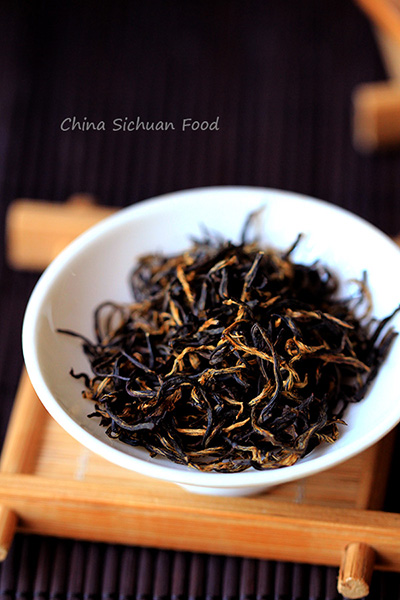

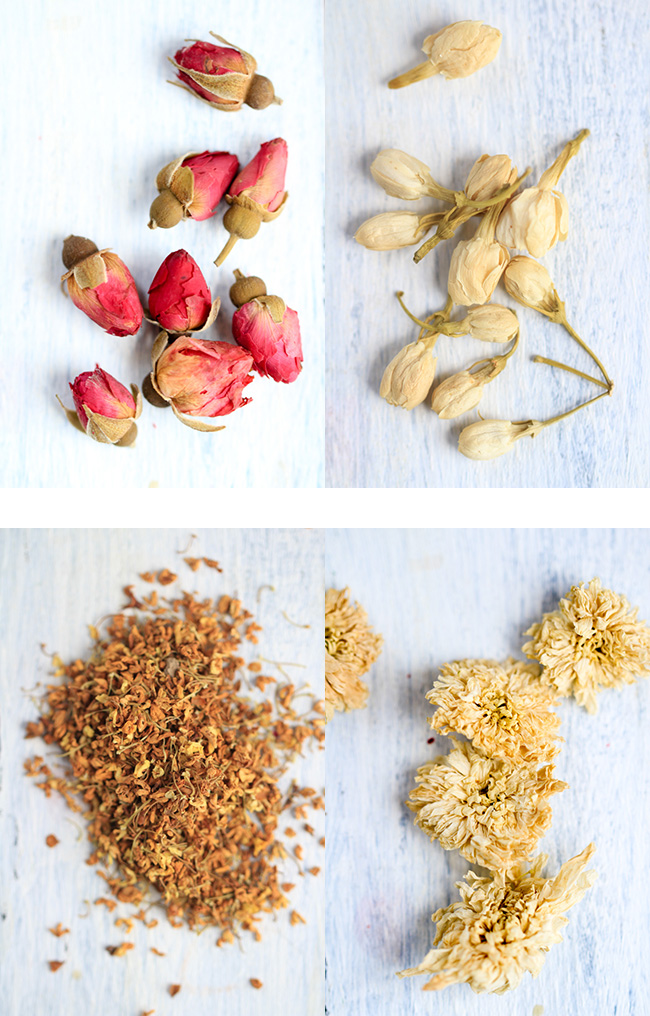
I really love this article, i just forgot the beauty and art of tea. I’m glad that i remembered it again ^^
Thanks! We both love the healthy benefits and tea ceremony process.
Elaine, I’m very fond of tea, too. Usually I have gunpowder, dragonwell, green jasmintea and some oolong on stock. I use to swirl the leaves in a bit of hot water immediately before brewing. But now I bought some delicious and expensive oolong with ginseng and am afraid to remove the precious ginseng if I do the swirling.
How do you brew you tea?
This article was a great help! I just came back from China and brought Laoshan Green Tea, Lavender (for my grandmother when she has trouble relaxing) and Rose tea (just because I like the flavor).
I wanted to bring many more but was unsure of what I would be buying and what effects they could have. So having this guide to flower tea now, I will order some of the other varieties online 🙂
I love to make my own mixes and flavored green or black tea with them as well. Rose green tea tastes great and now that I now the rose tea even has medical effects it is even better!
Flower teas have been enjoyed in China because of their different medical effects for quite a long time. Hope they will be helpful to your grand mother.
Just back from chengdu, jiuzhaigou, huang long, leshan and emei shan. Love the food at sichuan. Bought some ma jiao and hua jiao. Any advise to use the two spices? Thank you
Hi Yu,
I hope you had a great journey in China. Majiao and huajao are extremely popular in Sichuan cuisine and they can be widely used. You can check the link for some inspiration https://www.chinasichuanfood.com/?s=sichuan+pepper
Another flower tea is made from the Butterfly-pea flower and dried lemongrass and is a vibrant blue tea. The flower and lemongrass is also used to make blue rice.
I used to work at a bubble tea shop and we used real tea leaves so it was fun learning more about tea. One of my favorites was a rose oolong. I think it was iron goddess. Regular rose petal tea tastes too perfumey so the oolong added a nice flavor.
Flower teas are quite popular among tea drinkers now, especially for women. I love rose oolong and jasmine oolong the most.
Hi Elaine. I recommend you to try out osmanthus oolong. Gives the oolong this nice buttery smell
Thanks for the suggestion. Will try when meet.